Experts: Borneo in urgent need of protection
Experts: Borneo in urgent need of protection
Rhett A. Butler, mongabay.com
May 23, 2007
A prominent group of 1500 scientists in over 70 countries have called for the urgent conservation of Borneo’s forests, which are fast-disappearing on the southeast Asian island due to logging, fires, and conversion for oil palm plantations.
Wednesday the Association for Tropical Biology and Conservation (ATBC), the world’s largest scientific organization devoted to the study and sustainable use of tropical ecosystems, passed a formal resolution in support of immediate conservation action on the island.
“The situation in Borneo is bad—and getting worse,” said ATBC past-president William Laurance, of the Smithsonian Tropical Research Institute in Panama. “I don’t use words like crisis’ lightly, but that’s exactly what’s happening there.”
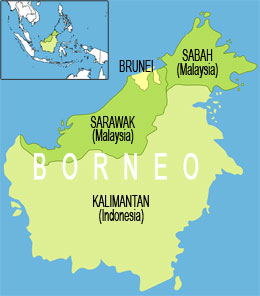
More about Borneo |
Since 2000 Borneo has had the world’s highest deforestation rate with annual forest loss approaching 4 percent per year. While the conservation community received positive news in February 2007 when the governments of Brunei, Malaysia, and Indonesia, working with WWF, agreed to protect roughly 220,000 square kilometers (85,000 square miles) of tropical forest in the so-called “Heart of Borneo”, the new ATBC resolution says that the move does not do enough to safeguard the island’s most biodiverse ecosystems: its lowland forests.
“The Heart of Borneo initiative is a big step in the right direction, and we endorse it in concept,” said Laurance. “But we believe it doesn’t go far enough to prevent large-scale species extinctions—at least in its present form.”
“The biggest problem is that lowland forests, which have been largely devastated, and those on nutrient-poor soils are not well-represented in the Heart of Borneo program,” said ATBC member Peter Ashton of Harvard University, who has spent nearly a half-century working in Borneo. “The lowland forests are the biologically richest in Borneo and contain many, many locally endemic plant and animal species, found nowhere else in the world.”
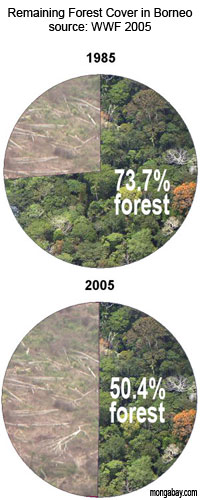
|
Further, say the scientists, many of Borneo’s species migrate between lowland and upland forest areas, and the loss of either could prove devastating to wildlife.
“Many species of Bornean birds and mammals move up and down elevational gradients and among different lowland habitats in order to find enough fruit and other food,” explained Rhett Harrison, secretary of the ATBC Chapter in Asia. “The Heart of Borneo needs to be expanded wherever possible to include more lowland and coastal forests, to help support these many migratory species.”
Laurance adds that though well-intentioned, the Heart of Borneo program will fall short of conserving Borneo’s forests and biodiversity.
“We endorse the Heart of Borneo and praise Indonesia, Malaysia, and Brunei for their wisdom and crucial support, but it’s vital that everyone realize this alone can’t save Borneo’s biodiversity. The Bornean nations and international community must also work to expand and defend protected areas, control rampant overhunting and forest destruction, and develop more sustainable forest-uses across the island.”
Since 1980 Borneo’s forests have been reduced by more than one-third, mostly as the result of industrial logging, which later fueled large-scale fires (especially severe in the el Nino years of 1982-1983 and 1997-1998) and land conversion for oil palm plantations. WWF projects that by 2020 less than one third of Borneo’s forest cover will remain, mostly in the central highlands of the island, while the United Nations Environment Programme (UNEP) says that 98 percent of organutan habitat will disappear by 2022. Presently about two-thirds of Borneo’s most biodiverse ecosystems, the lowland Dipterocarp forests, have been lost.
The full ATBC resolution follows.
Resolution concerning the Heart of Borneo’ transboundary conservation initiative
PICTURES OF BORNEO’S BIODIVERSITY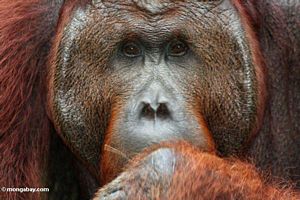 Male orangutan  Male proboscis monkey 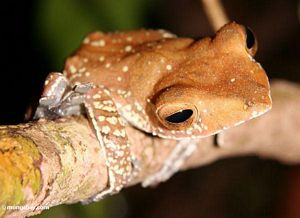 Tree frog  Emerald python 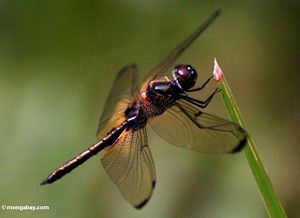 Dragonfly 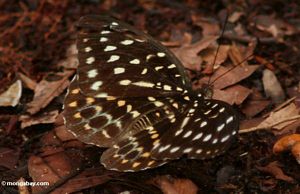 Female Archduke butterfly 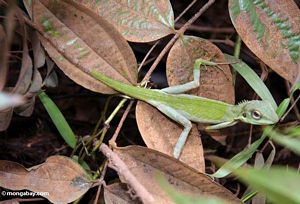 Green Crested Lizard Photos by Rhett A. Butler |
WHEREAS, the forests of Borneo are exceptionally species-rich in both flora and fauna, sustain a large proportion of locally and regionally endemic species, and have new species continually being discovered; and
WHEREAS, these forests store globally significant amounts of carbon in both their vegetation and soils; and
WHEREAS, Bornean forests provide homes, food, and other natural products to a large number of local peoples; and
WHEREAS, these forests are experiencing one of the highest rates of deforestation in the world (recently over 3.9% per annum) via poor timber-harvesting practices, conversion to plantations or agriculture, fires, and other threatening processes; and
WHEREAS, hunting and the international trade in wildlife products, in concert with vastly increased physical accessibility to forests via expanding road and logging networks, is having a devastating impact on many Bornean wildlife species, particularly larger vertebrates such as the Sumatran Rhino, primates such as the Orang Utan and Bornean Gibbon, and many birds including several hornbill species, pheasants, and raptors; and
WHEREAS, many of these declining species have important functional impacts on forest ecosystems as predators, herbivores, seed dispersers, and plant pollinators; and
WHEREAS, many compelling reasons exist for the protection of megareserves’ in the tropics, including maintaining viable populations of species that are vulnerable to hunting, forest fragmentation, and edge effects; reducing disturbance by fires; and providing the diverse range of habitats required by wildlife species that migrate seasonally along major elevational gradients or that move large distances in response to large, infrequent flowering and fruiting events; and
WHEREAS, the largest surviving tracts of undisturbed forest in South-East Asia occur in the Bornean transborder highlands of Brunei, Indonesia, and Malaysia; and
WHEREAS, the landmark declaration to support the Heart of Borneo’ initiative by the governments of Brunei, Indonesia and Malaysia, signed on 12 February 2007, will create important mechanisms to establish a network of protected areas and land under sustainable management totalling 240,000 km2; and
WHEREAS, forests protected by the Heart of Borneo initiative, as presently described, are largely concentrated in upland and montane areas; and
WHEREAS, the biodiversity of plants, invertebrates, vertebrates, and other species in Borneo has a remarkably complex geographical distribution, and is often concentrated in poorly protected lowland forests, in areas with unusual geologies and soil types, and in vulnerable coastal ecosystems;
THEREFORE, BE IT RESOLVED that the Association for Tropical Biology and Conservation, the world’s largest scientific organization devoted to the study, protection, and sustainable use of tropical ecosystems:
- APPLAUDS the Governments of Brunei, Indonesia and Malaysia (hereafter the transboundary nations’) for their pioneering decision to sign and support the Heart of Borneo declaration; and
- RECOGNIZES the leading role that nongovernmental organizations have played in promoting the critical Heart of Borneo initiative and in assisting the transboundary nations in its conceptualization, design, and implementation; and
- URGES the transboundary nations to recognize that the Heart of Borneo initiative, while of enormous importance, will not be sufficient in and of itself to protect Bornean biodiversity; and
- IMPLORES the transboundary nations to establish further protected areas in Borneo, especially in rapidly vanishing lowland forests and coastal ecosystems, either as part of the Heart of Borneo program or as separate initiatives; and
- IMPLORES the transboundary nations to improve biodiversity conservation in Bornean production forests, and to ensure that such forests are not simply converted to agricultural land-uses such as oil-palm plantations after logging.
- URGES the transboundary nations to improve the protection of their existing protected areas, especially for surviving reserves in lowland forests and other imperilled forest types, from illegal hunting, logging, encroachment, and wildlife trade; and
- URGES the international community, private sector, nongovernmental organizations, international aid agencies, scientific organizations, and government partners to provide direly needed financial and technical support for the crucial Heart of Borneo program and for related conservation initiatives to help protect the rapidly vanishing ecosystems and biodiversity of Borneo.
PHOTOS from BORNEO 
Borneo slide show: click image to play.
Larger version of the slide show | More Photos from Borneo